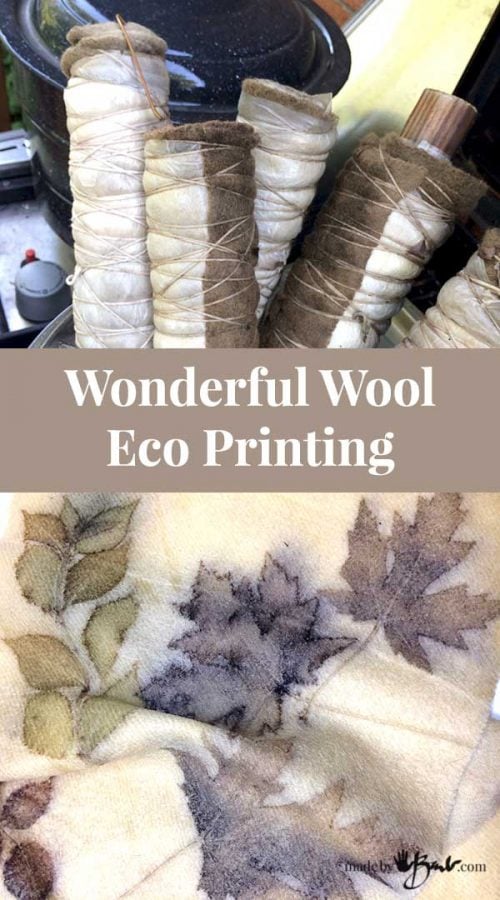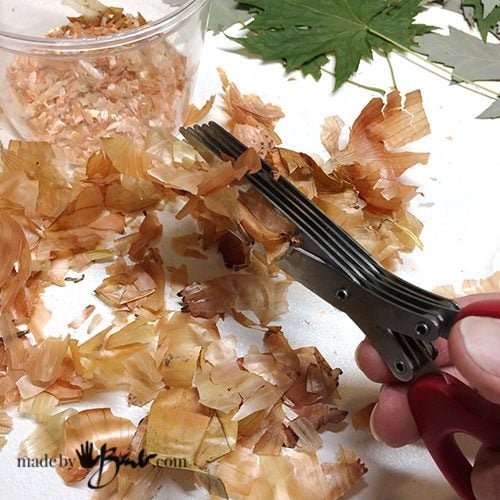Wonderful Wool Eco Printing
Many years ago precious pure wool blankets used to be the staple of a household. Nowadays they are being given up as the newer lightweights push them out of the linen closet. Lucky for us eco printers as they can now have quite the second life! You will love the Wonderful Wool Eco Printing and then go raid some linen closets…
Wonderful Wool:
As with the mittens wool can be used for so many things. These blankets came in many weights, quality and even colours. Some have been carefully stored and some have been washed and used. Depending on the weight they can become coats and jackets or accessories such as bags and scarves. Wool wears great and is not as fragile as you may think. Some have developed quite a ‘felting’ over the years. There is a lot of yardage in a blanket as well!
One of the easiest plant materials to dye wool is onion skins. Even with just a bit of pre-mordanting with vinegar (50% water for at least an hour) the wool prints oranges & reds easily with the skins. As a way of making shapes I cut them with some spice scissors.
I relied on my favourites such as maple and rose leaves as well as a newcomer; ‘wine weigela’. They have been pressed between newspaper until ready to use. Even after quite dried they can be reconstituted again.
This time the iron mordant is in the form of a soak in rusty iron water. I maintain a bucket of railroad spikes and water that I refresh with some vinegar now and then. I soak the leaves for about 30 minutes at least. Don’t be too strong with the iron as it will be harsh on the wool fibres and make it feel even scratchier. As with most of my projects I will do small test runs before investing a huge precious piece.
The wool tends to soak up a lot of moisture. It will keep dripping out the excess water as you work so its best to squeeze as much out as possible. Do not wring it as that may distort the wool. The prints will not be distinct if too wet. A towel to squeeze in will help wick the excess water.
Blot excess ‘iron-water’ from the leaves as well. Keep in mind that front and back print differently.
My intention was to have some background colour using the small flakes of onion skin. Be creative and unique. There are so many possibilities.
As an assurance that any prints will not bleed through to other layers, I cover in plastic (drop sheets are easily cut to the width and can be reused many times) before rolling.
The Rolling:
The wool blanket starts quite thick and fluffy. I find that tying tight with string can cause deep indentations that are pretty permanent. I came up with my own unique way of keeping the roll flat but also still able to breathe. Much like sushi rolling, I use a bamboo placemat on the outside of the roll. As you see wool can get bulky quite quickly.
Processing:
Another option is to leave some wool exposed to create interesting edge design by immerse boiling in some dye colour. The string/twine will act as a resist and I have often see it look like wonderful fringes on the edges.
If you would like a cleaner background and distinct prints then steaming for about 2 hours would be best. For some variation of colour and edges boiling would give more results. The addition of some dye stuffs ( leaves, onion skins, iron ) in the pot will add some colour.
The Reveal:
Once you have steamed or boiled they can be opened. I often like to keep some of the heat and let it cool slowly by wrapping in a thick towel/blanket rag. Anticipation… until the reveal!
Such wonderful reds! Since wool is a protein fibre it prints great. The pressing of the rolls also changes the feel of the wool and it becomes a more dense fabric.
They remind me of wool coat melton; thick and sturdy.
You just never exactly know what you are going to get! The wine weigela printed with slight reds and mauves. 
The Amazement:
Wonderful wool eco printing!
Oh, what to make with the great prints? How can I sleep with so many ideas floating through my head?! Pillows? Bags? Jacket? Journal? Vest? Quilt?
Alright, alright, here’s a sneak peek… I had better do this before we hit the heat of summer again…














These are amazing.I make owls from felted vintage wool blankets so I have a large stash on hand in every color.Could you use flowers like pansies?Our winters are long up here in Saskatchewan but spring can’t come soon enough to try this.
I know what you mean… as I’m in Canada too! We just had a thaw but still not going to cook outside! (I’m currently testing some other methods) But the oven can work as well if you have a really good ventilation method as some smells can be aggravating. Flowers seem like a good idea but most don’t create a colour that stays or can handle the heat. Experimentation is the key here. You can use felted blankets, even handfelted wool. Many use upcycled garments. It becomes an addiction I’m afraid as you never know exactly the outcome! Welcome to eco printing!
wow Barbra,This was a great amazing email.
You create so so much! I loved this wool eco-but never knew the Mordant!So 50/50% cheap vinegar and water?oka..may give this a try.
Thanks for all your shares.Debra/Nantucket
I am always interested in seeing the gorgeous results of Eco dying and the different techniques and processes used. What a fantastic idea with the herb scissors and onion skins. Absolutely love the detail photos of f the coat. Stunning!!! Well now I have to keep an eye out for a white or cream wool blanket when thrifting🤔. I found you through Pinterest. I am also Canadian from the interior of BC. Thank you for sharing your knowledge 😃
Considering that I spent most of my life illustrating nature, now nature is illustrating for me. What could be more fun?!
Such gorgeously detailed information. Thank you for being so generous. Can you use wool blanketing that normally sold for embroidery to make cot blankets? I can’t wait to try using the coloured squares blankets. Thanks again. I am in Australia where all the gum and eucalyptus trees roam.
Oh aren’t you fortunate to have eucalyptus in your own backyard! Some euca prints the most amazing reds! I have seen many print on old wool garments and coats so I think the wool blanket would work as long as it’s 100% wool. Nowadays its harder to buy fabrics that are not some polyester mix. To test unknown fabrics my mom used to burn a thread. If it melts it isn’t wool, if it smells like burnt hair then its prob wool. I always suggest small tests first…
Lovely, lovely work. Thank you for the details!
Thanks! you should try it…
Just lovely work Barb. Thanks again. Can’t wait till summer when I can experiment with leaves. I have a few madder plants and some others used for dying. Let’s see …
Yes! Experimentation is the key! It’s a mysterious journey… I’m looking forward to some fresh green even though I have not used up my dried ones yet.
I have discovered your site and a wealth of inspiration along with it!
One question: how do you safely clean the eco dyed wool?
Since wool is actually a hair you could use a simple mild shampoo. I use a PH neutral soap like Dawn. Do not wring wet wool. Squeezing is better…
I just read this site. I’m glad I found it! You have great tutorials!
I bought a used white cashmere blazer that I am anxious to try this method with.
I have dyed many (used) wool blankets…. gives them new life. I love wool. It breathes!
That’s great. I would still do a test run if you can. But sometimes I just ‘dive’ in as they can be overprinted or lightened with citric acid/lemon juice if needed… I am a bit of a collector of vintage wool blankets too!
How does the dyeing go with fall leaves? Do they have more color?
I am in Edmonton, Alberta.
As much as one would think that all the great colour would print its does not. I do get some rather darker prints from some of the rich colour leaves though, esp the maples. It’s all about giving it a try… you just never know!
Your work it’s amazing! I’m startint to try with my local trees and bushes, I live at Chile, south, and I want to boil every plant 😉
Thank you so much for sharing your experience. You are a great artist!
Oh, you may have such a different variety to choose from. It’s a process of finding the best printers and experimenting with mordants as well. Good luck!
I was so lucky to find a deal on wool at fabricland and now i wanted to do a shawl with my purplish wool/acrylic 40%. I would love to paint it and maybe do ecoprinting. Since it is mixed, I was wondering i should simply stick to light fabric paints. This is so exciting for some reason. Hope to hear from you all and barb too!
I have not painted wool at all. This eco printing is more related to dyeing than painting. Unless you use a thickened dye to paint with I am afraid it would be stiff and look very thick on the fabric. You could add interest with tie dyeing (adjust for wool) or shibori There’s alot of possibilities… The acrylic part will lighten any possibility of strong colours though.